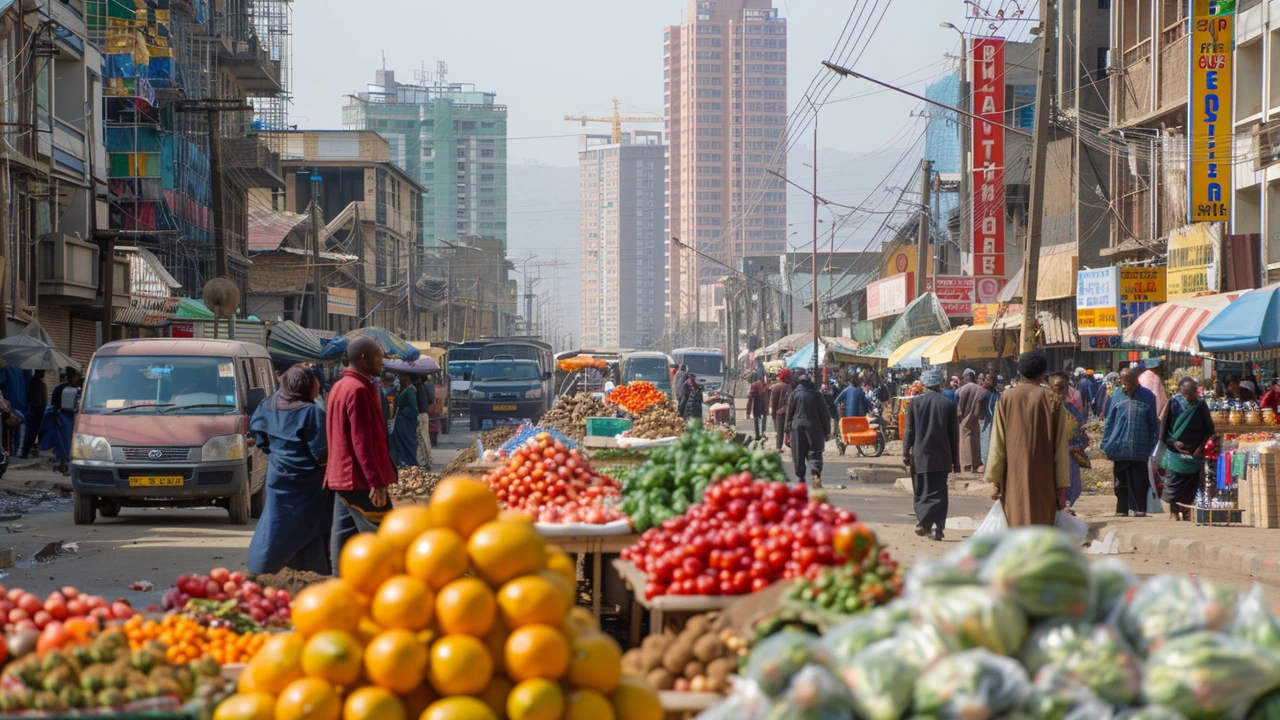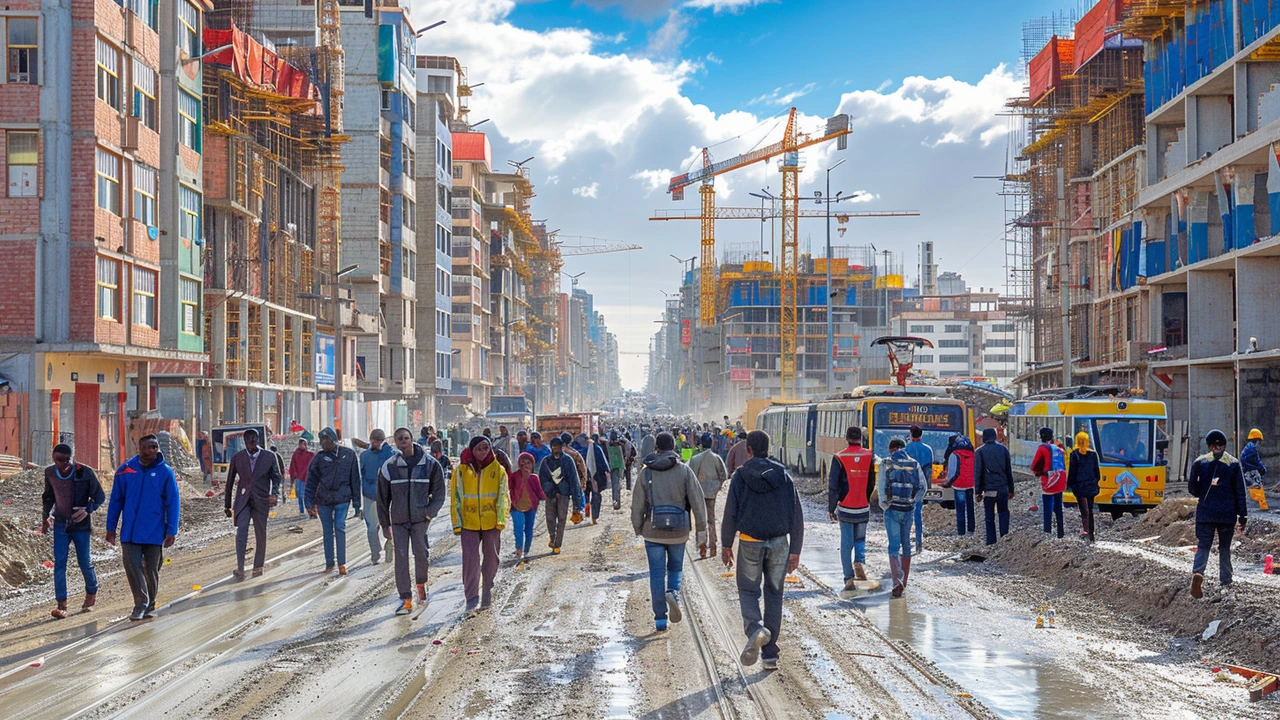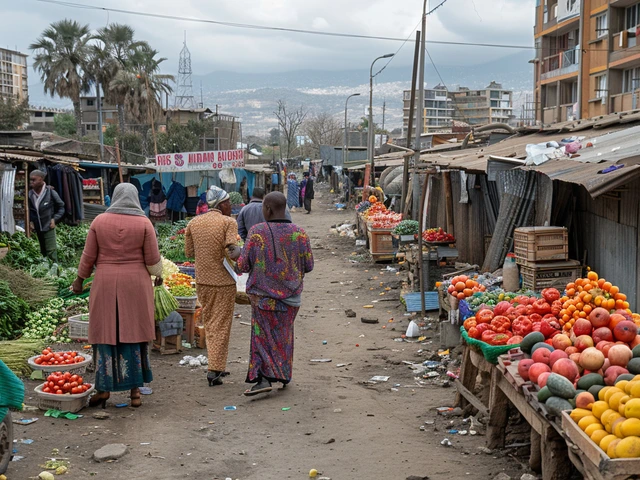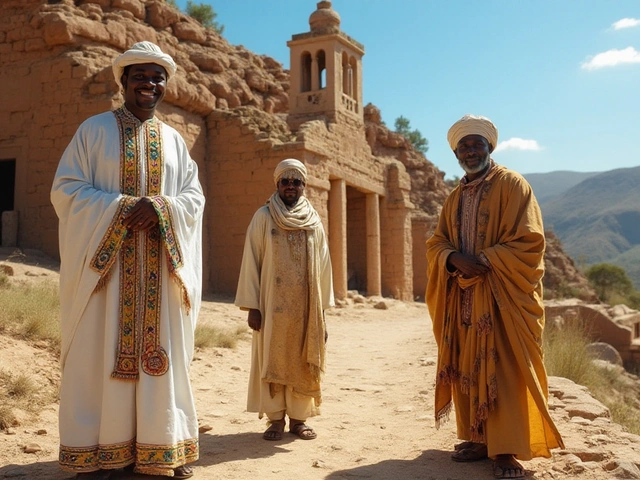The term 'Third World' might sound outdated to many, but it raises a critical question: where does Ethiopia stand on the global stage today?
With a rich history and a unique cultural heritage, Ethiopia has long been a land of contrasts—magnificent natural landscapes juxtaposed with areas of struggle and poverty. But to label it simply as a 'Third World country' might not capture the nuances of its current status.
In this article, we'll journey through Ethiopia's history, assessing its economic and social strides while also acknowledging the challenges it faces. By exploring various aspects like economic indicators, social development, and future outlook, we'll understand if this beautiful country still fits into the category of a 'Third World country' in 2024.
- Understanding Third World Terminology
- Historical Context of Ethiopia
- Economic Indicators and Growth
- Social Development and Education
- Challenges and Areas of Improvement
- Future Prospects and Outlook
Understanding Third World Terminology
When we mention the term 'Third World,' we often get images of underdeveloped countries with rampant poverty and lack of basic facilities. However, the origin of this term is more nuanced and deeply rooted in the geopolitical landscapes of history. Initially coined during the Cold War, 'Third World' was used to describe nations that were not aligned with either the NATO bloc (First World) or the communist bloc led by the Soviet Union (Second World). Over time, the term has evolved, but its connotations have often remained pejorative, used to label nations perceived as lagging in various socio-economic indicators.
Despite its historical context, using the term today can be quite misleading. Many countries traditionally labeled as Third World have made significant strides in various domains. For instance, several countries in Asia, once considered part of the Third World, are now thriving economies. Ethiopia, too, has been historically categorized under this term, but a deeper look into its socio-economic structure reveals that it might not entirely fit the outdated definition anymore.
Paul Farmer, a renowned anthropologist and human rights advocate, once said, "The idea of the Third World encapsulates a variety of injustices and disparities, but overgeneralizing ignores the resilience and progress many of these nations have demonstrated."
Today, the use of the term 'Third World' is problematic not just due to its historical baggage but also its tendency to oversimplify and stereotype diverse nations. As we delve deeper into Ethiopia's case, it becomes clear that the country's socio-economic landscape cannot be easily encapsulated by such a term. Historically rich and culturally vibrant, Ethiopia has shown remarkable resilience in the face of adversity, marking progress in many sectors including healthcare, education, and infrastructure.
To understand what categorizes a country as 'Third World' in the contemporary context, it's essential to focus on various indicators such as GDP per capita, Human Development Index (HDI), literacy rates, and healthcare accessibility. Ethiopia, for example, has experienced impressive economic growth rates in the past decade. While challenges remain, the country's development narrative is more complex and promising than a mere label of 'Third World' might suggest.
The key takeaway here is that labels often fall short of capturing the true essence of a nation's reality. The sweeping generalizations that terms like 'Third World' carry can be limiting and unjust. In the next sections, we will dive deeper into Ethiopia's journey through historical contexts, socio-economic growth, and development challenges to paint a more accurate picture of where it stands today.
Historical Context of Ethiopia
Ethiopia, often described as the cradle of civilization, has a history that stretches back thousands of years. It is one of the world's oldest countries, with its roots tracing back to the early hominid species. The famous remains of Lucy, an Australopithecus afarensis, were discovered in the Awash Valley, highlighting Ethiopia's ancient heritage.
The Kingdom of Aksum, arising around the first century AD, marks a significant chapter in Ethiopian history. This ancient empire was a powerful trading state in northeastern Africa, renowned for its monumental obelisks and the introduction of Christianity in the 4th century. The kingdom's influence extended over large parts of what are now modern Ethiopia, Eritrea, and Yemen. Its role in regional trade networks profoundly shaped the economic and cultural landscape.
Moving through the medieval period, Ethiopia continued to be a beacon of Christianity in Africa. The Zagwe dynasty, known for constructing the rock-hewn churches of Lalibela in the 12th century, left an indelible mark on the country's spiritual and architectural heritage. These churches, carved entirely out of rock, are now UNESCO World Heritage Sites and attract tourists from around the globe.
From the 13th to the 17th centuries, the Solomonic dynasty ruled Ethiopia, claiming descent from the biblical King Solomon and the Queen of Sheba. This period was characterized by relative stability, cultural flourishing, and the expansion of the Ethiopian Orthodox Church. The historical city of Gondar, with its impressive castles and churches, served as a royal and cultural hub during this time.
In the 19th and early 20th centuries, under the leadership of Emperor Menelik II, Ethiopia successfully resisted European colonization. The Battle of Adwa in 1896 was a defining moment; Ethiopian forces defeated the Italian army, ensuring the country's sovereignty. This victory became a symbol of anti-colonial resistance across Africa.
"Ethiopia's victory at Adwa was not just a triumph for Ethiopia, but for all colonized peoples striving for freedom." - Marcus Garvey
During the reign of Emperor Haile Selassie in the 20th century, Ethiopia underwent significant modernization. However, his downfall in 1974 led to years of political turmoil. The Derg regime, a Marxist-Leninist junta, took control, initiating a period marked by violence, famine, and internal conflict. This era left deep scars on the nation's socio-political fabric.
In 1991, the Ethiopian People's Revolutionary Democratic Front (EPRDF) ousted the Derg, ushering in a new era of relative stability and economic reform. The country began making strides in infrastructure, education, and healthcare. However, challenges remained, including recurring droughts, ethnic tensions, and political unrest.
Today, Ethiopia stands at a crossroads, reflecting a blend of its rich historical legacy and the contemporary quest for growth and stability. The country is dynamically evolving, aiming to transform its historical resilience into sustainable development.

Economic Indicators and Growth
Understanding the economic landscape of Ethiopia in 2024 requires a look at several key indicators that paint a vivid picture of its progress and challenges. Ethiopia, known for being one of the fastest-growing economies in Africa over the past decade, has shown remarkable resilience and potential.
One of the most significant economic indicators is the GDP growth rate. In recent years, Ethiopia's GDP has been growing at an average rate of 7 to 10 percent annually. This growth is largely attributed to sectors like agriculture, services, and manufacturing. Agriculture remains a backbone of the economy, employing a significant portion of the population. However, there has been a gradual shift towards industrialization, with investments pouring into manufacturing zones like the Hawassa Industrial Park.
Ethiopia has also been focusing on infrastructure development. Major projects like the Grand Ethiopian Renaissance Dam (GERD) promise to transform the energy sector, bringing a substantial boost to the country's electricity generation capabilities. Roads, railways, and new airports are rapidly developing, facilitating better connectivity and trade. This development is crucial for landlocked Ethiopia, seeking to enhance its trade routes and economic opportunities.
Another aspect worth noting is foreign direct investment (FDI). The Ethiopian government has been proactive in creating an attractive environment for investors, with policies aimed at fostering business growth and reducing bureaucracy. According to the United Nations Conference on Trade and Development (UNCTAD), Ethiopia attracted approximately $4 billion in FDI in the past year, signifying international confidence in its economy.
Despite these positive indicators, Ethiopia still faces several economic challenges. Inflation remains a pressing issue, reflecting the struggle to balance economic growth with cost control. Additionally, the political landscape and occasional conflicts can pose risks to economic stability. Yet, the country's leadership continues to emphasize economic reforms and stability as part of their national agenda.
The financial sector, although expanding, has room for improvement. Access to credit is limited for small and medium-sized enterprises, which are vital for job creation and innovation. The government is working on enhancing financial inclusion through initiatives like mobile banking and microfinance programs.
As we contemplate Ethiopia's economic journey, a poignant observation from the World Bank highlights the delicate balance Ethiopia seeks: "Ethiopia's rapid economic growth has lifted millions out of poverty, yet sustaining this growth while ensuring it is inclusive remains the country's greatest challenge."
"Ethiopia's unparalleled growth rates are testament to the determination of a nation to rise above historical constraints," stated the African Development Bank in a recent report.The path ahead for Ethiopia involves not just leveraging its strengths but also tackling the underlying challenges head-on.
In summary, the economic indicators suggest a promising trajectory for Ethiopia, marked by substantial growth and the potential for significant transformation. However, the journey is fraught with challenges that require strategic planning and robust policies to ensure sustainable and inclusive growth. The narrative of Ethiopia's economy is one of ambition, resilience, and the constant pursuit of improvement.
Social Development and Education
Ethiopia's journey in social development and education tells a compelling story of resilience and progress. Despite starting from a place of considerable challenges, the country has made significant strides in improving its social infrastructure and education system over the past decades. The nation's commitment to better the lives of its citizens is evident through various reforms and initiatives.
In recent years, Ethiopia has achieved notable progress in primary education enrolment. According to UNESCO, the primary school enrolment rate in Ethiopia has surged to over 90%, showcasing the government's effort to make education more accessible. This leap forward has been supported by investments in school infrastructure, teacher training, and curriculum development. However, challenges such as high dropout rates and quality of education still need addressing.
One insightful indicator of social development is the country's healthcare system. Ethiopia has reduced its child mortality rate substantially. From 2000 to 2020, the under-five mortality rate fell by more than 60%, thanks to improved healthcare services, vaccination programs, and a focus on maternal health. These improvements have contributed to a healthier population and underscore the government's efforts to enhance public health.
Education is a critical aspect of social development, and Ethiopia has recognized this by adopting policies aimed at not only broadening access but also improving the quality of education. The General Education Quality Improvement Program (GEQIP) is an example of such initiatives, aimed at upgrading the learning environment and resources available to both teachers and students. Additionally, technical and vocational education and training (TVET) programs in Ethiopia are designed to prepare youth for the job market, aligning educational outcomes with socio-economic needs.
Challenges and Efforts in Social Equity
While the progress in education and healthcare is commendable, Ethiopia faces ongoing challenges in achieving social equity. Rural areas, home to a significant portion of the population, often lag in access to quality education and healthcare services. Efforts to bridge this gap include mobile health clinics and community-based education programs. These initiatives aim to extend essential services to the most remote and underserved regions, but there is still a long road ahead.
"Ethiopia's achievements in social development are significant, but sustaining and expanding these gains requires continuous commitment and innovation," says Alemayehu G. Mariam, a renowned scholar on Ethiopian affairs.
The path toward social development in Ethiopia is a mix of promising advances and lingering challenges. While the numbers show substantial progress, the stories from within the country reflect the efforts and aspirations of a nation striving for comprehensive development. With a strong focus on education and healthcare, Ethiopia is laying the foundation for a better future, one where all citizens can thrive.

Challenges and Areas of Improvement
Ethiopia's journey toward development is punctuated by numerous challenges that hinder its progress. One of the most pressing issues is poverty, which remains widespread. Despite economic growth, a significant portion of the population lives below the poverty line. This economic disparity stems from various factors, including a largely agrarian economy vulnerable to climatic changes and insufficient industrial diversification.
Political instability and governance issues also pose substantial hurdles. Ethiopia has seen internal conflicts, such as the Tigray conflict, which have disrupted development and strained resources. These conflicts not only result in humanitarian crises but also deter foreign investment and hinder sustainable growth. Building a stable political environment is critical for the country to achieve its developmental goals.
Health and education systems require significant improvements. Though there have been strides in increasing access to education, the quality remains a concern. Many schools lack basic facilities and trained teachers, affecting the overall educational outcomes. In healthcare, access to facilities and qualified medical staff is limited, especially in rural areas. These limitations contribute to poor health indicators, such as high maternal and infant mortality rates.
Infrastructure development is another area that needs attention. Many rural areas are disconnected from major cities due to poor road networks and limited access to electricity. This isolation hampers economic activities and restricts access to markets and services. Investments in infrastructure, like roads, electricity, and internet connectivity, are crucial for integrating rural areas into the broader economy.
Environmental issues also present a significant challenge. Ethiopia is prone to droughts and environmental degradation, which impact agriculture — the backbone of its economy. Addressing these issues requires sustainable agricultural practices and better management of natural resources. Climate change exacerbates these challenges, making it essential for the country to adopt resilient strategies.
Ethiopian Prime Minister Abiy Ahmed once said, "Our nation is like a tall tree that must remember the roots. Only when we acknowledge our challenges can we grow stronger and taller."
The Ethiopian government and international partners are working on various initiatives to mitigate these challenges. Programs focused on poverty reduction, education reform, and healthcare expansion are in place, yet implementation remains a hurdle. Corruption and bureaucratic inefficiencies often slow down progress, making it imperative to enforce transparency and accountability in governance.
Addressing these challenges will require a multifaceted approach. It involves not just government efforts but also the engagement of local communities, private sector participation, and international cooperation. By focusing on these areas, Ethiopia can pave the way for a more vibrant future, gradually moving away from the lingering label of a 'Third World country.'
Future Prospects and Outlook
As we look towards the future, Ethiopia's trajectory seems to be one of cautious optimism. Though the nation has faced numerous challenges, several positive indicators suggest a brighter future on the horizon. Economic reforms and infrastructure development spearheaded by the government are among the key factors contributing to this optimism.
With the expansion of the Grand Ethiopian Renaissance Dam (GERD), Ethiopia aims to become a major player in renewable energy. The dam has the potential to generate more than 6,000 megawatts of electricity, which could not only uplift the local economy but also turn Ethiopia into an electricity exporter for the region. This is expected to boost the nation's revenue and open new employment opportunities.
Another promising area is the agricultural sector. Ethiopia's fertile lands have always been its backbone, but advancements in farming technology and practices are starting to show significant improvements in productivity. Investments in modern irrigation systems and high-yield crop varieties could further enhance food security and export potential. By embracing these developments, Ethiopia can tackle the pressing issue of food insecurity which has long plagued the region.
One cannot overlook the strides being made in the education sector. Initiatives aimed at improving literacy rates and providing quality education to the youth are paying off. Recent studies indicate a promising rise in school enrollment rates, particularly among girls. This focus on education is vital for nurturing future leaders and innovators who can drive Ethiopia towards a more prosperous future.
“Education is the most powerful weapon which you can use to change the world,” once said Nelson Mandela. Ethiopia seems to be embracing this philosophy as it gears up for a knowledge-based economy.
Healthcare is another area where progress is evident. Efforts to improve healthcare infrastructure and provide better access to medical services are showing positive outcomes. The government, along with international aid organizations, has been working to curb the spread of diseases and improve general health metrics. Vaccination programs and initiatives aimed at treating chronic illnesses have been effective in reducing mortality rates and improving life expectancy.
However, it's essential to keep in mind the challenges that still loom large. Political instability and regional conflicts pose significant threats to sustained progress. Ensuring peace and political stability will be crucial for maintaining the upward trajectory. The youth unemployment rate is another critical issue that needs addressing. Sustainable job creation through various sectors, including technology and manufacturing, is vital for keeping the young population engaged and productive.
Looking at the bigger picture, Ethiopia's integration into the global economy is a key factor that could shape its future prospects. By fostering trade relations and attracting foreign direct investments, the nation can capitalize on its abundant resources and strategic location. Participation in regional trade agreements and efforts to ease business regulations can create a more attractive environment for investors.
The future of Ethiopia is filled with potential. While acknowledging the hurdles, the combination of robust economic reforms, a focus on education and healthcare, and strategic investments in infrastructure heralds a promising outlook. With determination, effective policies, and international cooperation, Ethiopia could very well shed its 'Third World' tag and emerge as a beacon of growth and stability in the Horn of Africa.

 Why is Ethiopia's Economy Growing So Rapidly?
Why is Ethiopia's Economy Growing So Rapidly?
 Top High-Paying Jobs in Ethiopia in 2024
Top High-Paying Jobs in Ethiopia in 2024
 Is Ethiopia a Good Place for Business Investment in 2024?
Is Ethiopia a Good Place for Business Investment in 2024?
 Investing In Ethiopia: How Much Do You Really Need?
Investing In Ethiopia: How Much Do You Really Need?
 Top 3 Religions in Ethiopia: Insights into Faith and Culture
Top 3 Religions in Ethiopia: Insights into Faith and Culture
Patrick Van den Berghe
June 16, 2024 AT 17:50Ethiopia's GDP growth is impressive but still masks deep rural poverty.
Josephine Gardiner
June 16, 2024 AT 20:20In reviewing the material, one observes a conscientious effort to contextualize Ethiopia's development within both historical and contemporary frameworks. The analytical tone remains measured, avoiding sensationalism while acknowledging progress. Particular emphasis on economic indicators provides a solid foundation for the argument. Moreover, the incorporation of social metrics such as education and health illustrates a comprehensive approach. It is commendable that the discussion refrains from reductive terminology, thereby fostering a nuanced understanding.
Jordan Fields
June 16, 2024 AT 22:50The article presents accurate data on Ethiopia's recent GDP growth rates. It correctly notes the ongoing challenges in inflation control. The mention of infrastructure projects aligns with recent investment reports. Overall, the prose is concise and grammatically sound.
Divyaa Patel
June 17, 2024 AT 01:20Ah, Ethiopia – a tapestry woven with threads of ancient grandeur and modern turbulence! The narrative dances between the luminous peaks of progress and the shadowy valleys of hardship, each step dripping with paradoxical beauty. One cannot help but feel the pulse of a nation straddling destiny, its people forging hope amid stark realities. The economic surge feels like a phoenix, yet the flames of poverty still lick the outskirts. Cultural vibrancy erupts like fireworks, dazzling the world while the undercurrents of conflict whisper unsettling lullabies. Education, that fickle muse, flutters forward with vigor, though unevenly. Health strides shimmer, yet remote villages remain cloaked in neglect. In short, Ethiopia embodies a living paradox, defying any single‑dimensional label.
Larry Keaton
June 17, 2024 AT 03:50Yo folks, let me break it down – Ethiopia's on a rollercoaster ride right now! The economy's booming, but don't get fooled, there's still a ton of peeps hustlin' in the fields with barely enough to eat. The new dam project? Massive! It's gonna light up whole towns, but the politics around it are messier than a laundry basket in a storm. Rural areas? Still laggin' behind – roads are pothole jungles and internet's a myth. And yo, the education push is solid, but schools are short on teachers and textbooks – kinda like trying to stream a movie on dial‑up. Health care's getting better, but clinics are still an hour away for many. You gotta respect the hustle, but also call out the gaps – we can't just pat ourselves on the back and ignore the real struggles. Keep pushing, keep talking, but also keep an eye on those who are still stuck in the grind.
Liliana Carranza
June 17, 2024 AT 06:20Hey everybody, feel the electric vibe of Ethiopia's surge! The nation's spirit is soaring, and those new tech hubs are lighting up the skyline like fireworks on a night of possibilities. Education is blossoming – kids are grabbing books like they’re treasure maps, and that energy is contagious. Health initiatives are buzzing too, turning challenges into stepping stones for brighter tomorrows. Yet, we must stay grounded and lift each other, because true progress shines brightest when everyone gets a seat at the table.
Jeff Byrd
June 17, 2024 AT 08:50Oh great, another “deep” dive that somehow still feels like a shallow pool.
Joel Watson
June 17, 2024 AT 11:20The discourse surrounding Ethiopia's classification warrants a dispassionate examination.
One must eschew the seductive allure of reductive labels that conflate disparate metrics into a singular pejorative.
Contemporary development indices, such as the Human Development Index, reveal an incremental ascent that defies the archaic moniker of "Third World."
Moreover, the nation's infrastructural endeavors, epitomized by the Grand Ethiopian Renaissance Dam, constitute a paradigm of strategic statecraft.
The macroeconomic trajectory, characterized by sustained double‑digit GDP growth, substantiates a narrative of burgeoning prosperity.
Nevertheless, the specter of endemic poverty persists, demanding a nuanced appreciation of intra‑national disparities.
Agricultural productivity, while improving, remains vulnerable to climatic volatility, a factor that intermittently throttles growth.
The political milieu, albeit fraught with episodic unrest, has exhibited a commendable degree of resilience.
Educational attainment rates have risen, yet the quality of pedagogical delivery warrants further scrutiny.
Healthcare outcomes demonstrate measurable progress, particularly in child mortality reduction.
Financial inclusion, however, lags behind, impeding the diffusion of entrepreneurial dynamism.
In summation, Ethiopia occupies a liminal space between emergent and established economies.
To consign it unequivocally to the "Third World" category would be an intellectual abdication.
Scholars must therefore adopt a lexicon that encapsulates complexity rather than perpetuating obsolescence.
Only through such calibrated discourse can policy frameworks be appropriately calibrated.
Chirag P
June 17, 2024 AT 13:50Your analysis is thorough, yet it overlooks the lived realities of citizens who navigate daily hardships despite macro‑level gains; acknowledging those ground‑level experiences would render your argument more holistic.